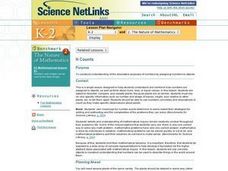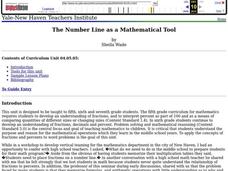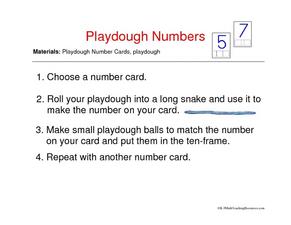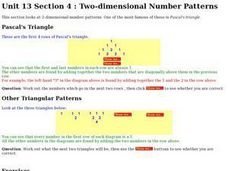Curated OER
It Counts
Students classify and compare plants using specific information, observations, and numbers. In this mathematical inquiry lesson, students use plant characteristics to describe, compare, and classify them. They attempt to develop a system...
Curated OER
The Number Line
Learners graph and order numbers using a number line. They also solve word problems using fractions and decimals and rewrite equations to solve problems correctly. Several example word problems are given.
Curated OER
Fraction Number Lines 4
Third, fourth, and fifth graders use this learning exercise to review fractions on a number line. Basic and tricky fractions are used to complete the missing fractions! For your lower-level learners, consider providing little squares of...
Curated OER
Fractions on a Number Line
Number lines can be used to show fractions. Use this basic worksheet to introduce this concept to third and fourth grade learners. There are three number lines provided, and your learner must fill in the missing fractions.
Curated OER
Missing Numbers to Twenty
Which number is missing? Beginning counters examine twenty-six number sequences, one for each letter of the alphabet. Each sequence has four numbers, ranging from one to 20. There is one number missing from the sequence, and learners...
Curated OER
Playdough Numbers
What a fun way for youngsters to practice numbers! Using Playdough (or another type of moldable dough, which can be made at home easily), learners create lengths to place over large number cards, tracing the numbers 1-10. Then, they...
Curated OER
Expanded Shells
Practice expanded and standard notation in this beach-themed addition activity. You will need to cut out the shell templates, which are in three groups: ones, tens, and hundreds. Learners choose one from each group, then use the...
Curated OER
Addition Number Chart
Number charts are a great way for learners to practice counting and observe number patterns. There are four charts here with missing numbers for scholars to fill out. Each contains some numbers filled in as reference. Challenge...
Curated OER
How Many Ducks in the Pond?
Kindergarten counters will be delighted to doddle with the ducks pictured on a two-page illustrated worksheet. The six story problems and two equations ask learners to add and subtract as the ducklings dabble in the pond. An answer...
Curated OER
Counting Squares
Build solid foundational skills by counting to ten. Each slide contains concrete objects to count and both the numeric and word representation of each item counted. For example: Learners will count 2 red squares, see the number 2 and the...
Curated OER
Counting the Puppies
Kindergarten counters will be pleased to play with plump puppies and respond to seven prompts about these pets. The instructional activity includes five counting questions, one addition question, and one subtraction question. The playful...
Curated OER
Decimals, Percents, and Fractions
Learners practice converting fractions, decimals, and percentages to communicate equal amounts. They fill in a table, determine the percentage of a total area that is shaded in diagrams, complete equations with decimals to the hundredths...
Curated OER
Reviewing Names, Greetings, Numbers
¡Hola! Young learners need to review basic greetings and numbers the first week of school. To introduce learners to each other, have the kids form two circles, one inside the other. The inside circle faces out (so that they're looking at...
AGradeMath.com
Working With the 10,000 Chart
Calculate the answers to problems that are multiples of ten to help your class discern patterns in the zeros and learn to sequence. Each person receives a 10,000 chart, but s/he must discover that on their own through estimation and...
Curated OER
Problem Solving: 100 Board Logic Problems
Get mathematicians engaged with number terminology using this puzzle activity! Learners determine the selected number from a hundred board by eliminating numbers using clues. As a group, each learner has a specific role, outlined in the...
Curated OER
Number Patterns in Everyday Life
Examine scenarios involving number patterns. Learners complete a series of activities, including working with Pascal's triangle ando completing chart activities based on different pricing for pizza toppings. An included extension has...
Curated OER
Two-dimensional Number Patterns
In this online two-dimensional number patterns worksheet, students solve eight in-depth two-dimensional number patterns. Students check their answers as they go.
Curated OER
Multiplication Packet
It's all things multiplication in this fifteen-page packet! Learners switch off between problem-solving and math puzzles, increasing in difficulty as they move through the packet. Helpful examples precede all the problem-solving...
Curated OER
Write the Missing Numbers
Which numbers are missing on these hundreds charts? Beginning counters fill in the blank squares in a set of hundreds charts. One simply has the numbers 1 and 100, while the others are missing every other number, only even numbers, or...
Curated OER
Where We Live
Who has the most? Young learners practice charting data using familiar information. They help fill out a classroom chart by recording the number of people, pets, televisions, etc. in their home. Guiding questions help them investigate...
Curated OER
It Has Been Rubbish For Years
Students are presented with the problems of percentages and focus upon numbers in contrast to 100. They calculate problems with money and are engaged with the use of games as a teaching tool. Students also interpret data as presented in...
Curated OER
Addition Worksheet
In this addition learning exercise, students will determine the sum of 20 double digit addition problems where they must utilize regrouping.
Curated OER
Primary Understanding and Use of Place Value
Explore place value and regrouping with your class. They develop awareness of several ancient number systems and how they differ from the base ten system commonly used today. They play "Chip Trading" with partners to practice addition...
Curated OER
Fun Math Worksheet 46
In this addition instructional activity, students add five digit numbers together to find a sum. Students complete 15 addition problems with and without regrouping.

























